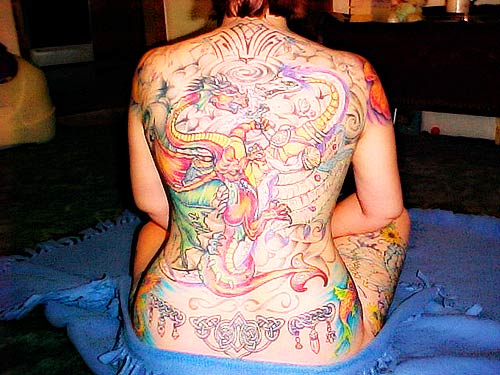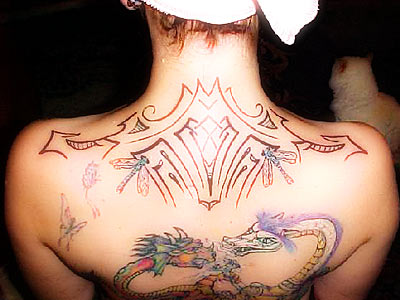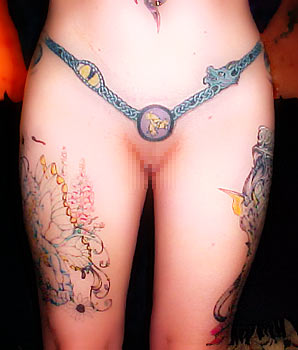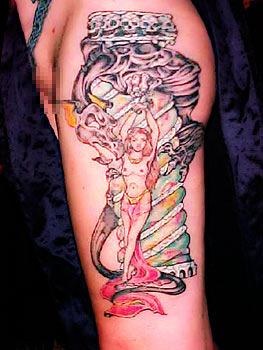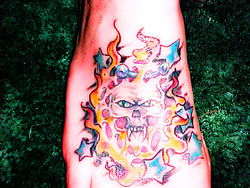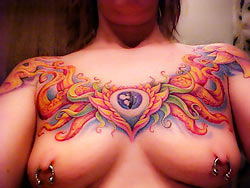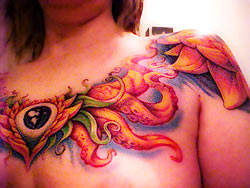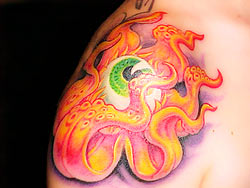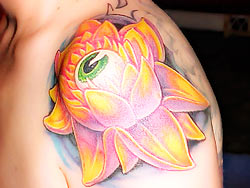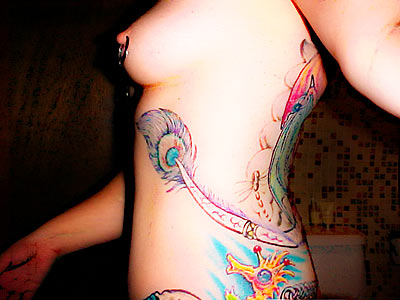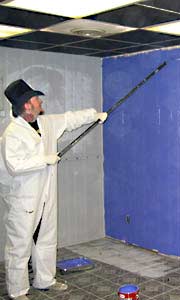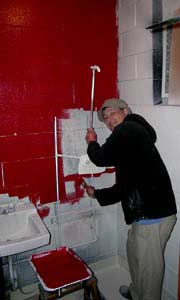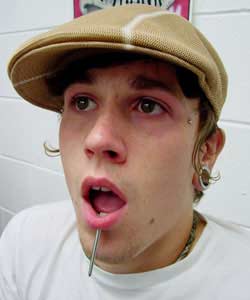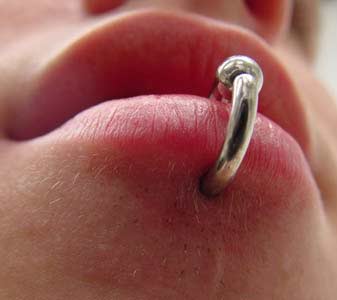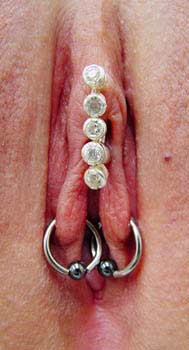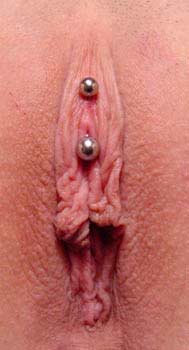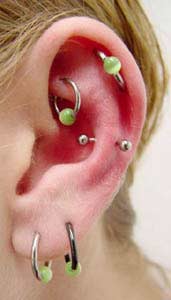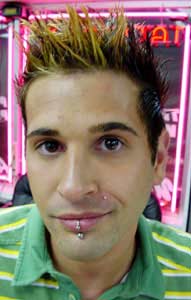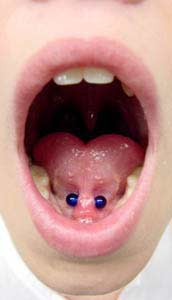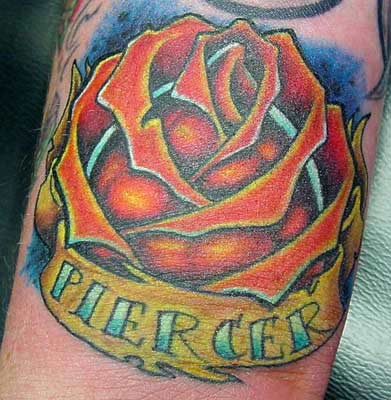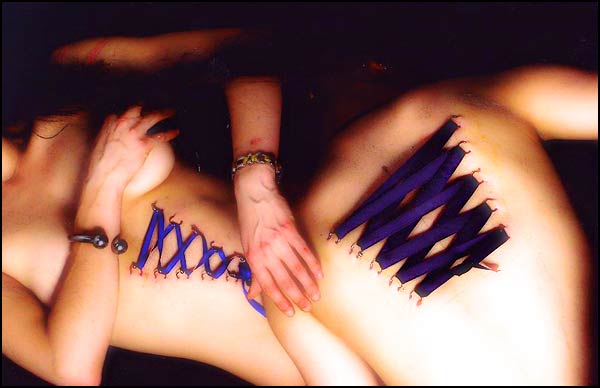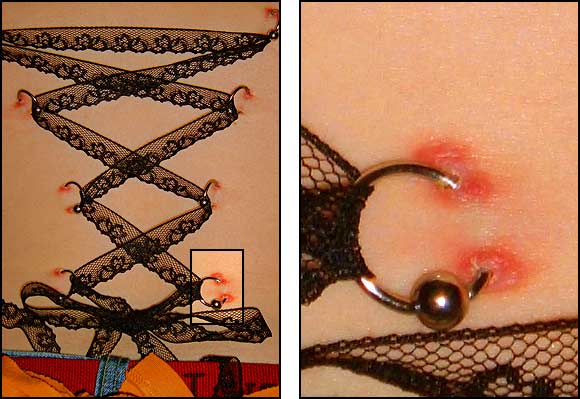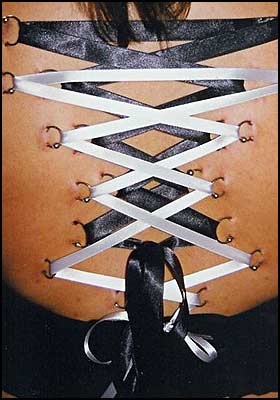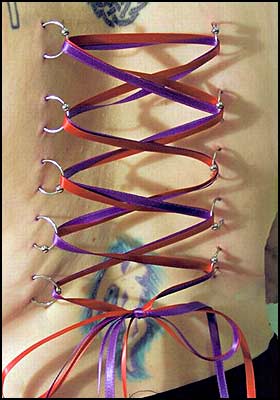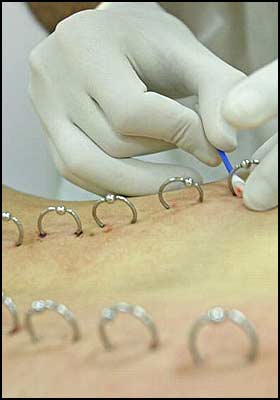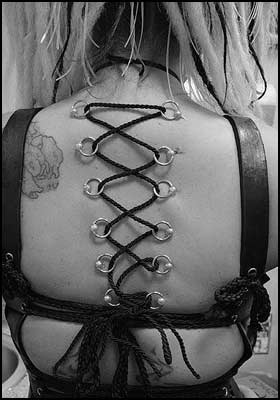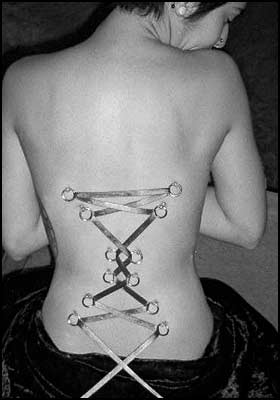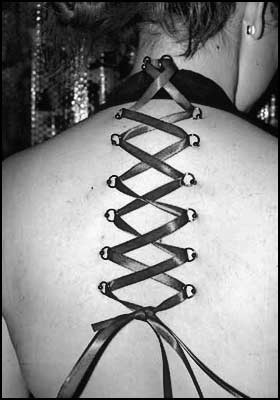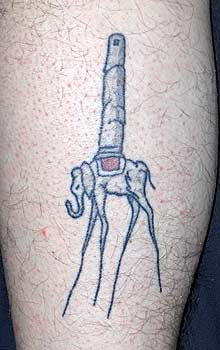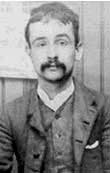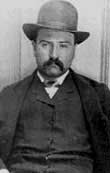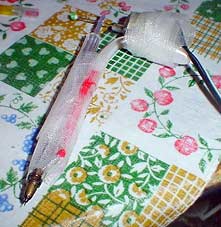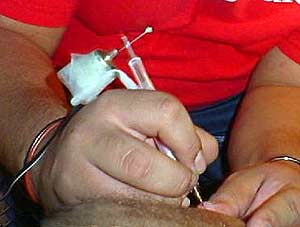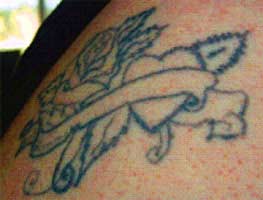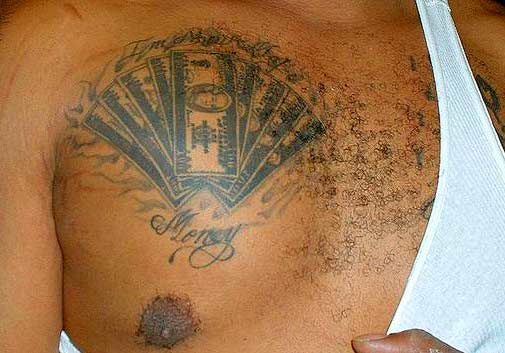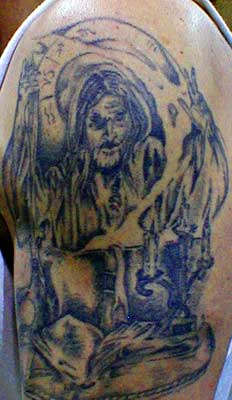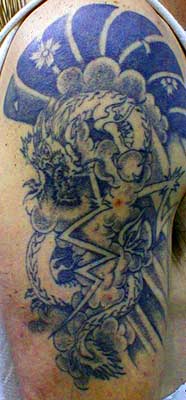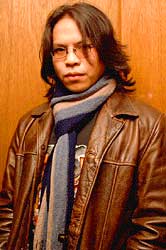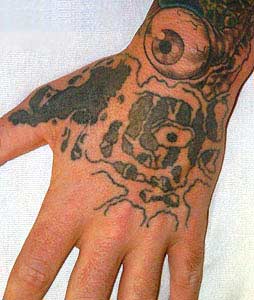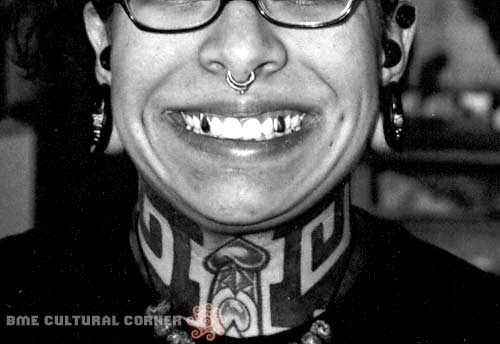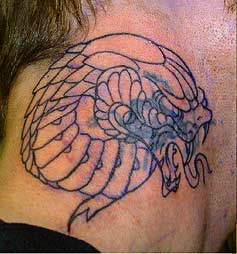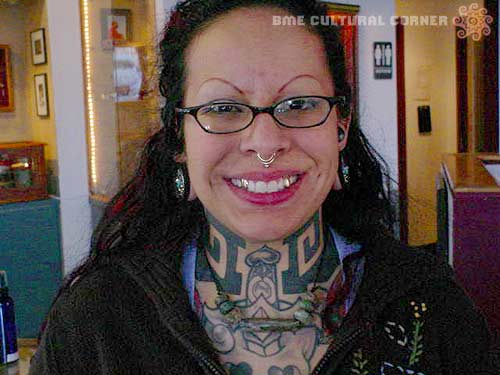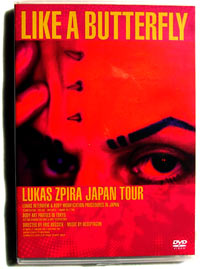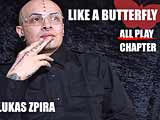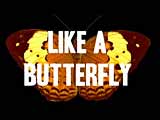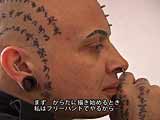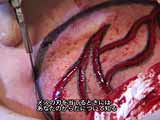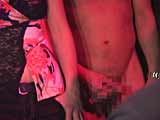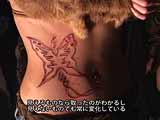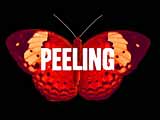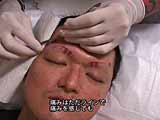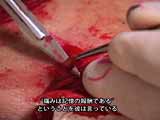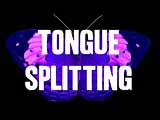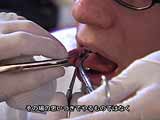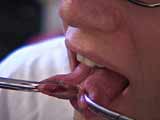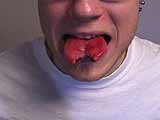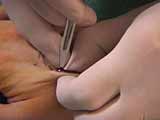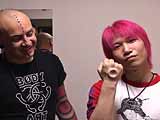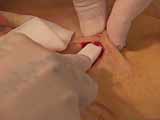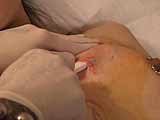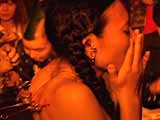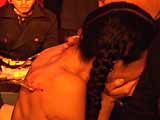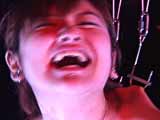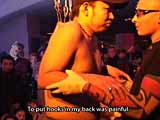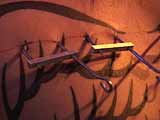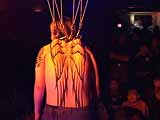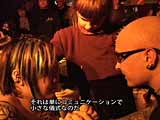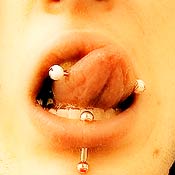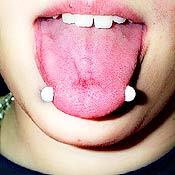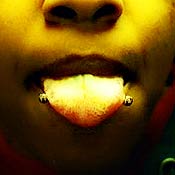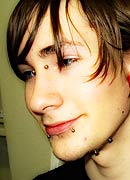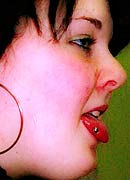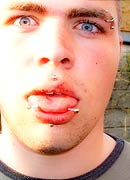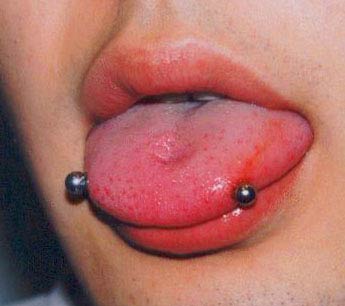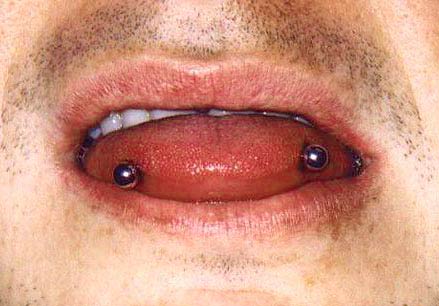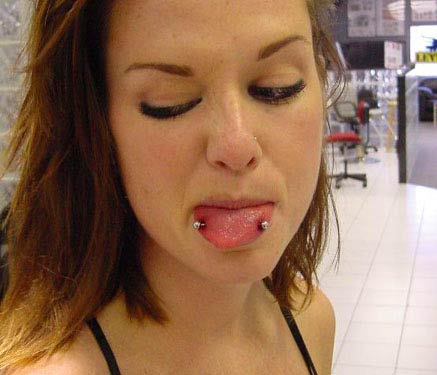| BME: |
What gave you the idea to get a horizontal tongue piercing? |
| PIERS: |
I love to get unique piercings, and I hadn’t seen it anywhere before so it seemed like a good idea at the time. Vertical tongue piercings also are known to be sexual aids, so I thought that a horizontal one might be quite interesting too. The vertical tongue piercing tends to be very standard and is widely accepted now, yet if you simply rotate it, it becomes so much more. |
| PAMELA: |
Well, I’m kind of the odd duck… I’ve always been into body mods. I had my navel done twice but my body rejected it both times before it had even healed, so I wanted something that my body would actually allow. I found BME and started looking around, and was immediately drawn to the horizontal tongue — I had never even heard of it being done that way — but I waited probably a good six or seven months before I actually did it.
|
| GREGG: |
To be totally honest I was going through a stage in my life where I had to be better than everyone else. The only problem that’s created when your friend thinks he’s a professional piercer and you can buy needles down at your local Wildcat shop? You end up with some weird and wonderful piercings!
I’d actually only been into piercing for about three months — before that I vowed I would never get one, and disliked them immensely. But then I saw an eyebrow spiral, got one, and was hooked.
The vertical tongue piercing looked too boring, and a horizontal one seemed a good idea at the time. I’d been warned that you should never get a horizontal tongue piercing on a whim, so what do I go and do… I’m sure you can guess!
|
| STEVE: |
I already had a vertical tongue piercing, which was one of my first piercings, but I wanted something that was different and looked good. Then I saw a horizontal tongue piercing on a girl at Erotica, an adult industry trade show in London. After chatting to her I decided I wanted it done — I wanted something that I could say, “look what I got” because at the time, piercings were just starting to get popular. I have no spiritual or whatever reason… I just wanted it because it looked cool.
I searched the net and came up with a picture on BME. I took that with me to the piercer and when he eventually did it, he positioned mine as close to that picture as he could. I think mine’s pretty similar to his:
|
| |
 Steve’s Horizontal Tongue Piercing
Steve’s Horizontal Tongue Piercing
|
| BME: |
What factors did you think about when considering getting it done?
|
| STEVE: |
I thought about how it might affect my job, the potential for damage to nerves in my tongue. What if it were to hit one of those huge veins? I was considering all kinds of things about the possible damage to my taste buds and motor functions in my tongue, as it’s pretty deep into the tissue. I thought about potential speech difficulties, heavy bleeding, and at the time I had heard some rumors about tongue piercing implications with cancer and stuff. There was also possible dental damage, so I had a lot of health issues to consider.
The final factor it rested on was work. Would I be able to speak properly enough to do my job as a night club promotions manager — where it was key to be able to talk and chat to customers, and deal with businesses.
|
| PIERS: |
Tell the truth, I didn’t really think about the consequences. This was during my early days of piercings and I didn’t really listen to the warnings of trained piercers.
|
| PAMELA: |
Rejection was a battle with my navel and I didn’t want that going on inside my mouth, and then there was my mother: what she would say when she found out I did it?
|
| BME: |
Had your piercer done this piercing before? What did they think about your request?
|
| PIERS: |
I found out later, that Venom, my piercer, actually was very talented, but at the time I didn’t really care how experienced she was — as long as she would do the piercing!
She wasn’t nervous at all — probably more excited than anything. She explained about how it would swell, especially since I was having two in the same session (both vertical and horizontal ones), and talked me through how horizontal tongue piercings have a high chance of hitting something, or not lasting due to discomfort, and so on.
|
| GREGG: |
My piercer had never done it before. Having your friends stick holes in you really isn’t the safest option in the world, but at the time he had his own piercing studio and had all the proper sterilized equipment.
|
| STEVE: |
I knew my piercer had no experience with this kind of piercing, but he has a portfolio that included a lot of stuff I’d never seen, and he said he was always learning new stuff. However, initially he said “NO!” point blank. I called every piercing studio within a hundred miles and couldn’t find anyone else.
After a few months and a few piercings later I mangaged to talk him into it and he explained it all to me: the risks, the dangers, the unlikely issues, as well as the remote issues that would probably never happen, but he told me it all.
|
| BME: |
Since piercers often yearn to do unusual work, did you have to pay for the piercing, or did they do it for free or at cost?
|
| PIERS: |
I had agreed on a special price with her… I think I paid 30 pounds for both piercings I got that day [between $50 and $60 US].
|
| GREGG: |
Mine was free.
|
| STEVE: |
I paid about ten pounds for mine [$20 US].
|
| BME: |
What was the jewelry were you pierced with?
|
| GREGG: |
At first I had a 1.6mm — 14ga — PTFE barbell with PTFE balls so I wouldn’t smash my teeth on them. I later changed it to a metal barbell with metal balls, at the same size.
|
| STEVE: |
Originally the plan was to use what we had available — a one inch long steel barbell. However, when I worked it out, I figured it wouldn’t be able to rest it in my mouth due to the immense length, so we settled on PTFE and small 4mm beads on the ends so that they wouldn’t be too obtrusive and sit nicely in my mouth.
They’re now so unobtrusive that they can slide inside my tongue — I should actually put bigger ones on to stop that, but I think if I do, the hole where the current ball goes will stretch and I don’t want that. Now I have a one inch PTFE in it right with 4mm stainless steel balls on the ends.
|
| BME: |
How was the piercing itself done, and what did it feel like?
|
| PAMELA: |
OH! It was horrible! I was crying and begged her to stop halfway through. She told me she couldn’t, and then shoved the needle the rest of the way through my tongue. That is why if you look at it close enough it is crooked.
|
| GREGG: |
We did the piercing in a garden… I know you may consider this dangerous or dirty, but I felt safer being under the bright blue sky than in some room that resembled a doctor’s office. I wouldn’t advise anyone to follow me in this — this is just personal preference, and I’m sure most piercers wouldn’t do it anyway.
We decided clamping my tongue and going as fast as possible seemed like a good idea at the time, although my view now has changed and I would’ve preferred going slowly freehand, as this would increase the chance of getting a good straight line through my tongue.
It felt rather unpleasant; the pain didn’t really abate from when the needle went in till the jewelry had taken its place. There’s a good twenty or thrirty seconds of pain in comparison with the mild discomfort of a tenth of a second that the average piercing gives you.
|
| STEVE: |
The week before doing the piercing we checked for veins and the likes with a torch (flashlight). The day of the piercing I got there with a few of my friends, waited a few minutes while he set everything up, and then he lead the way to the piercing room. I hopped up on the gurney and waited as he took a pair of large clamps out from the autoclave and dried them off.
He inspected my tongue again, and placed these clamps, made a few adjustments, and then locked them into place.
He sprayed Xylocaine on my tongue, and then asked me to take deep breaths — which I was already doing — and placed the needle against my tongue. He slowly started to push the needle through, with the odd stop and change in direction and stuff to make sure it was straight, and then a last push and he was through.
The pain was more of an intense burning, nothing like my normal tongue piercing. It felt like a small needle prick, then rapidly got hotter until it was stinging, and then felt more like it was burning as it went through. It felt like four or five minutes but I’m assured it was less than thirty seconds.
|
| PIERS: |
Mine hurt the most out of any other piercings I’ve had. It was closest to my medusa (top labret), just on sheer scale, rather than actually what it felt like.
|
| GREGG: |
Yeah, to say it hurt would be an understatement.
I looked straight up, watching the clouds roll by, and then a blinding sensation went through my whole face… Not unbearable, but certainly close to intolerable. I remember someone telling me to slow my breathing down or I’d hyperventilate.
|
| BME: |
How did you feel afterwards?
|
| GREGG: |
It looked great! I was so happy — I hugged everyone, washed my face, and did the best impression of someone with absolutely no use of their tongue… Worst lisp in history!
|
| STEVE: |
I washed my mouth out with ice cold water, and got a little relief. Then my piercer looked at it and said it looked damned good… I couldn’t talk or anything — I just mumbled and left his room and he told me to come back in a few days. As I walked out a few of my friends were waiting and they were like, “oh god I can’t believe you did that” and they were like “you’re mad” all the way to the pharmacy.
|
| |
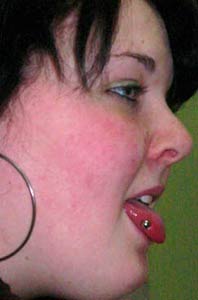 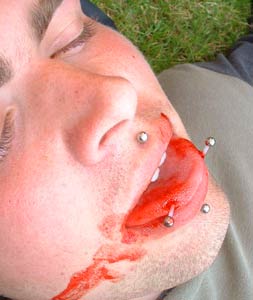 Pamela’s piercing not long before removal, and Gregg’s very fresh piercing.
Pamela’s piercing not long before removal, and Gregg’s very fresh piercing.
|
| BME: |
Did you change the jewelry during the healing process?
|
| PAMELA: |
About a month later when I went to a shorter barbell, I think an inch or an inch and a half.
|
| STEVE: |
I just clipped a millimeter (or four) off the PTFE bar and rethreaded it as the swelling went “up” not down, so my tongue actually got narrower and I clipped the PTFE to match. Once the swelling was gone I had to get another PTFE bar to replace it as it had returned to being wider.
|
| BME: |
What was the healing like?
|
| STEVE: |
The healing was very much like my other tongue piercing, only it took maybe six times longer. It’s now healed and I can take the bar out easily and replace it. It can still act up if I catch it or anything like that, but overall, it’s fine.
The only real issue I had during healing was eating bread or bread-like food, as it got stuck on the balls and hurt like hell, and that’s still a problem sometimes, but I think I have unknowingly adapted to that one.
|
| PIERS: |
To be honest, the piercing was very embarrassing, as it gave me a really bad lisp and I found it incredibly hard to eat. I had a constant lisp the whole time I had it in. It restricted my tongue from moving to pronounce the correct sound. It was very frustrating after a while.
|
| PAMELA: |
Well, it took about five months until I no longer had an infection or a swollen tongue in the mornings… but I toughed it out, lisp and all.
|
| BME: |
You had the lisp the whole time?
|
| PAMELA: |
Yes, I had a lisp until I took it out… After I took it out, it was another five months, when the tongue was fully healed, before my speech was perfect.
|
| STEVE: |
My lisp stopped as soon as the tenderness and swelling went down. I had a few issues with talking, but it was mainly with shouting. I still have those problems, but it’s a small price to pay.
|
| BME: |
Was there a lot of swelling in comparison to a normal tongue piercing?
|
| PIERS: |
I had both of them done at the same time so I wouldn’t know, yet when my horizontal piercing was taken out the swelling completely disappeared in a few days, so it kind of lead me to believe that most of the swelling was from the horizontal one.
|
| PAMELA: |
Yes, it was hard to talk for the entire time I had it because of the swelling, and I didn’t eat anything solid for over two weeks.
|
| GREGG: |
In my case there was hardly any swelling at all.
|
| BME: |
What kind of aftercare did you give it? Did your piercer suggest something special?
|
| PIERS: |
I’ve always just used salt water — it seems to be the most effective thing for me.
|
| STEVE: |
My piercer always suggests one part Listerine to three parts water, mixed into a water bottle, and I am to rinse after each meal and snack, and first and last thing in the day.
|
| |
|
| BME: |
Did your piercer warn you anything you’d have to look out for or be careful about?
|
| PAMELA: |
Actually, she didn’t. I only found out a month or so ago that the tongue is two muscles on the left and right side, and that it’s really bad for them to be pierced like that.
|
| STEVE: |
My piercer mentioned veins and nerves and other such things… one of the ones he was concerned about was the movement of my tongue — but I had thought about that beforehand and was pretty much determined to go through with it.
|
| BME: |
What’s the most annoying thing about having it?
|
| PIERS: |
The fact that I couldn’t smoke, eat, or talk properly.
|
| PAMELA: |
The lisp. I had a huge speech impediment. People who knew me well would always comment on it, but others that didn’t know me didn’t know if I had it before. I had problems with the healing on the right side of the tongue. I don’t know what happened there, but the barbell sunk into my tongue and in order for me to talk properly, the ball would have to be inside my tongue!
|
| GREGG: |
I had problems closing my mouth, eating, talking, chewing gum — pretty much anything orally.
|
| STEVE: |
The most annoying thing other than people always asking to see it, asking how long I’ve had it, and did it hurt — the usual things — is that it has a tendency to flare up over the slightest mistreatment.
|
| BME: |
On the other hand, what’s the best thing about it?
|
| PIERS: |
It looks amazing and it’s so rare. It’s getting very hard nowadays to get a piercing that is truly rare — don’t get me wrong, I love the fact that body modifications have become more widespread, but I just prefer having unique piercings and styles.
|
| PAMELA: |
I liked the fact that it showed my individual style, and that I do things for me and not for everyone else. The “Ahh cool”s were pretty sweet too!
|
| GREGG: |
It’s pushing your body beyond its normal state to create something you feel happier with — although this could be said for any piercing.
|
| STEVE: |
The best thing about this piercing is that it’s a defining piercing — when I attend IAM meets, and I do attend a lot of them, it’s the one piercing people identify me by, and I always get asked about it. Most people are surprised by the amount of time I have had it, and I have never met anyone else who has one or had one. I also love the shock value from the non-pierced folks at work!
|
| GREGG: |
You can’t really beat walking down the street with a bar going through the tip of your tongue (and peoples expressions)… Oh boy, did I get some expressions, from sheer horror to total respect and admiration.
|
| BME: |
Any problems with chipped teeth or other dental issues?
|
| PIERS: |
I only really thought about it after I bit down on one of the balls. Luckily no damage was done. I decided to move onto foods that only involved sucking or swallowing without chewing!
|
| PAMELA: |
I now have a big chip on my left front upper tooth that I want to get fixed soon. That is from when I would tighten the balls I would hold it there with my teeth.
I don’t think I had it long enough for major damage other than that one tooth chip to occur. For a while I used plastic balls, but they were internally threaded and would always break off. I got tired of that so I just went back to metal ones.
|
| GREGG: |
Not really. I am of that stupid breed of people who deem the piercing more important than the complications of the pierced party — however, my mind has since changed on the subject, and I would take a lot more into consideration over these sorts of factors so I didn’t do something I might later regret.
|
| STEVE: |
The only damage I got was when my bead came off while I was eating a hamburger, and I bit onto the bead and chipped one of my bicuspids. It’s a bit of a nuisance, but as it’s only a small chip, I don’t mind.
|
| |
|
| BME: |
When you took it out, what were the factors in making the decision?
|
| PIERS: |
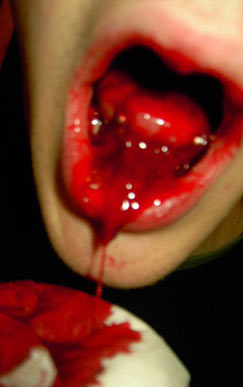 |
|
Piers’ piercing forces him
to consider a trip to the hospital.
|
I didn’t have a chance to rest the piercing. With my job I was constantly talking and shouting over the music in the club. One night I was working and I tasted a little blood in my mouth so I decided to go to the toilets and check it out. There was a slight bit of blood but I didn’t want to take any chances, so I went upstairs to the night club to pack up my camera and say goodbye to a mate on the bar. As I was trying to get out more and more people kept asking me to take their photos and dragging me further back into the club. By the time I got out it had started bleeding a bit heavier. I managed to stop it with pressure but a few days later while I was treating myself to a packet of smoky bacon crisps it started bleeding again, and quickly got worse and worse until I was spitting blood and some rather unpleasant blood clots.
Even though I was reluctant, I knew it was time to take it out. When I finally did, I was really bleeding, and I made a phone call to a mate for a round trip to the local Accident & Emergency ward, as I felt like I was going to pass out. Doctors don’t really appreciate self-inflicted wounds so I ended up stopping the bleeding myself in the toilets.
|
| PAMELA: |
My lisp was probably the biggest factor. Biting on the balls, and one side didn’t heal properly. It just wasn’t worth it.
|
| GREGG: |
I removed mine because it wasn’t straight enough, and because of discomfort and annoyance at not being to talk properly. I only kept it for three days.
|
| BME: |
Steve, why do you think you’ve had so much success with keeping this piercing?
|
| STEVE: |
The key for me has been give and take. If I take the time to look after my piercing, it’s fine, but if I get careless, it’s problematic. If I mistreat the piercing it will swell. The secret is: make some changes and learn to deal with it, or you’re going to have problems.
|
| BME: |
What advice would you have for others thinking about this piercing?
|
| PIERS: |
Go for it! But if it was anything like mine, be prepared to change what you eat, how you eat, and how you talk. Hardcore body modification!
|
| GREGG: |
Do what you think is best — don’t rush something like this though, as it’s not something you should dive into without careful consideration of the consequences.
|
| STEVE: |
Give it serious thought because there is the risk of dental damage, muscle damage, nerve and vein damage.
|
| BME: |
Do you consider this a viable piercing?
|
| PIERS: |
I know one girl with it in the area I live in, and she’s got pictures of it healed so why not? Just because it didn’t work for me doesn’t mean it won’t for you.
|
| GREGG: |
Perhaps in the future, but why take the risk of harming the way you speak? Your speech is the way other people can recognize the being that is you, and if you have nice teeth and can’t afford corrective dentistry, then why take the risk?
|
| STEVE: |
For me, absolutely. If for some reason this has to come out or starts to migrate I will remove it, heal it, and get it done again.
|
| |
|
| BME: |
Was it all worth it?
|
| PIERS: |
It was definitely worth it. I still consider this to be a very beautiful tongue project. The only reason I took it out was because of the bleeding. To tell the truth, I don’t regret any of my piercings, but this is definitely a piercing that I would like to have again.
|
| PAMELA: |
Honestly, no, it’s not. The five months healing time alone was crazy on my part. Every morning I wanted to take it out, but I always wondered, “what if it’s so cool when it’s healed?”
Well, it was cool when it was healed, but then the lisp and all the other problems made it suck… but if the one side didn’t pull through I probably would have kept it!
|
| GREGG: |
If you’d have asked me this question two years ago I’d have told you it was all worth it and I was getting ready to have it repierced, but in hindsight, I don’t think it was worth it, but it depends on your mindset. Too many young people get a piercing to be different, and too many piercers do piercings like this to show they’re on the edge of their science. In the big scheme of things it isn’t worth it to damage other parts of you for the sake of being unique, although it just depends where you draw the line.
|
| STEVE: |
I have worked my way into two managerial jobs with two mainstream companies with my piercings and all. One of them is my main job in a night club called “Heaven and Hell” in Stockport. I am the first line of contact with the public and even with my piercings, I have the job, and I have worked my way up the ladder.
I would sacrifice my livelihood over it though, and I almost did when I went to claim unemployment — I refused to take it out and they could have refused my benefits but I showed them my resumé and proved I can and will get work.
It’s definitely worth it, purely because after nearly a decade of having it, it’s still a rare piercing, and not many people can say they have that these days!
* * *
|
Giving us the story from the other side of the needle is Matt Bruce (IAM: modsbymatt), an active piercer at Body Jewellery and Piercing in Victoria, British Columbia. He’s performed several horizontal tongue piercings, and turned away even more customers asking for it. He’s here to tell us, from a piercer’s point of view, some of the most important things to know about the piercing.
|
| |
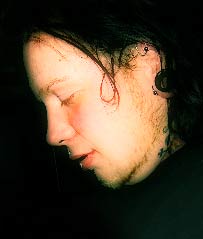 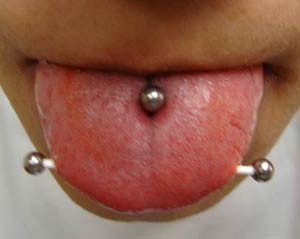 Matt, and a horizontal tongue piercing done on one of his customers.
Matt, and a horizontal tongue piercing done on one of his customers.
|
| BME: |
What kind of cautions do you need to take that are different than a normal, vertical tongue piercing?
|
| MATT: |
I researched this one for a while, thinking I was missing something, but it seems that as long as the blood vessels taper off before the area you are piercing in, it tends to be hassle-free.
|
| BME: |
What kind of jewelry do you use, and why?
|
| MATT: |
I use PTFE barbells because they bend with the movements of the tongue itself. A stainless or titanium barbell will only get in the way while trying to talk and eat and such, and Tygon has to be changed too often. I prefer to use PTFE beads as well but if they want stainless, I just make sure the jewelry is short enough that the beads sit inside of the teeth.
|
| BME: |
Can you explain the process of making sure the customer is suitable for the piercing and of doing it?
|
| MATT: |
Like I said, as long as there are no obvious blood vessels in the area, that’s a good start. I find that if they fold up the tip of the tongue and at the fold there is an indent on either side than they have good anatomy for it, but that doesn’t mean they are good for the piercing.
Good oral hygiene and previous experience with piercing and oral piercing is a must, and then, based on all those variables, I decide from that point if I will do the procedure. If everything is a go, I make my entrance and exit marks and then brace the tongue with a piece of gauze in-between my thumb and first fingers. After everything is lined up, I push the needle through to the other mark and then follow through with the jewellery.
|
| BME: |
Do you warn the people about possible dental damage or other potential problems?
|
| MATT: |
Of course. As a professional piercer it is my obligation to inform people of any possible negative effect that any procedure could have on the client.
|
| BME: |
How much should customers expect eating, drinking, talking, and so on to be affected?
|
| MATT: |
They will find it awkward at first, the same as any other tongue piercing, but with PTFE it makes it very easy to adjust. Usually at the two week point they tend to be talking well and the distension is almost completely gone.
|
| BME: |
What advice would you have for others thinking about this piercing?
|
| MATT: |
Make sure you see examples of the piercing in the artist’s portfolio that you approach and I would say that if they recommend a metal barbell, then I would look somewhere else. Also, just because this or any piercing has been done does not mean it can be done on you. If someone turns you away because you do not suit the work you want don’t just keep looking till you find someone that will!
|
| BME: |
Do you consider this a generally viable piercing?
|
| MATT: |
That is a hard question to answer. For some, a navel piercing isn’t viable, for others a standard tongue piercing isn’t. I try and just go person-to-person with every procedure I do. If it is viable for that individual then I do it.
|
| |
|


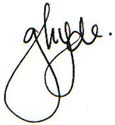


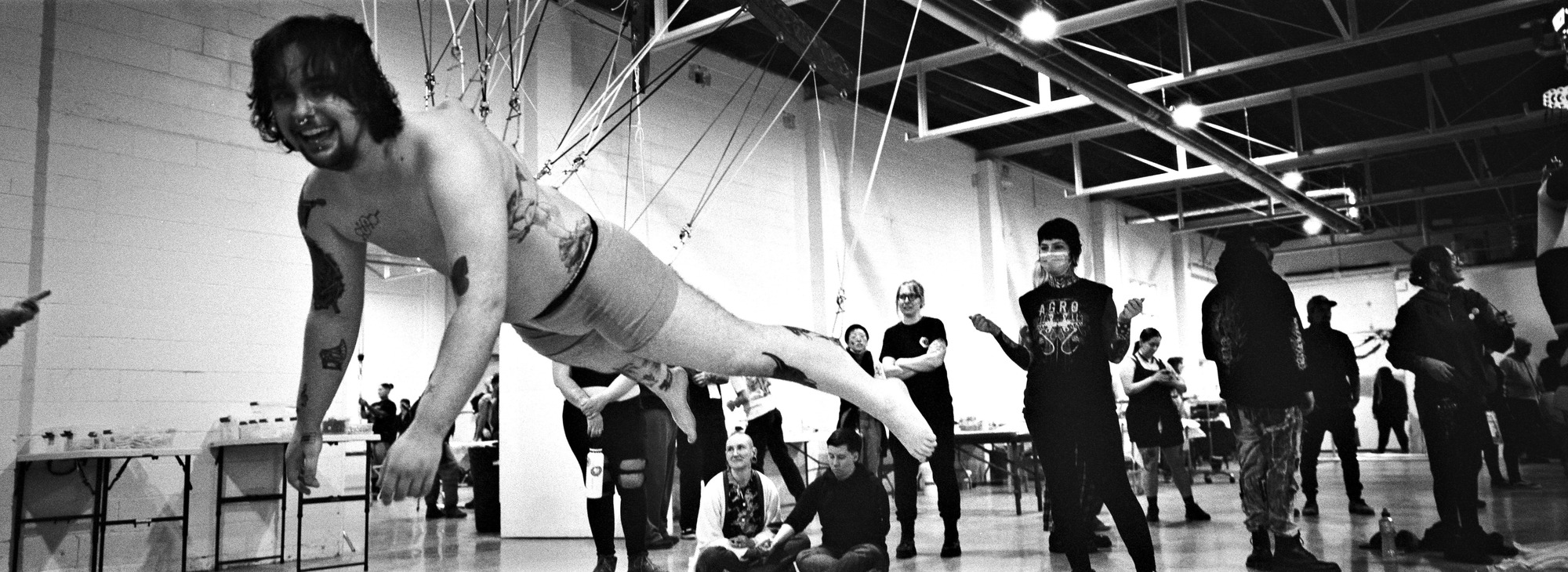
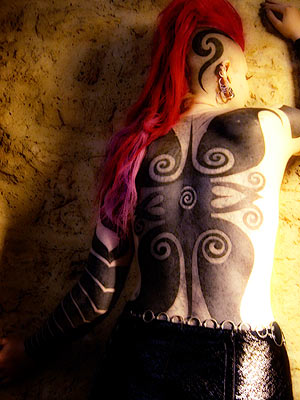
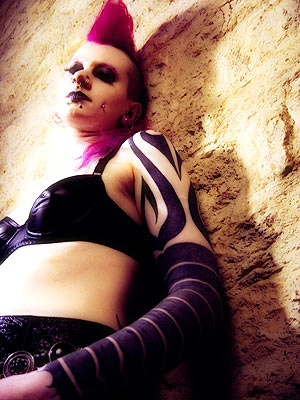
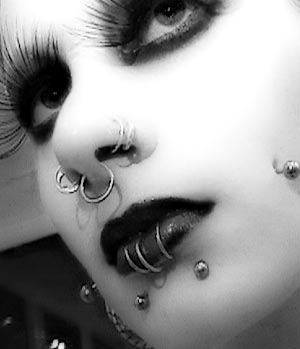
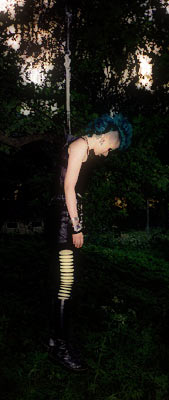
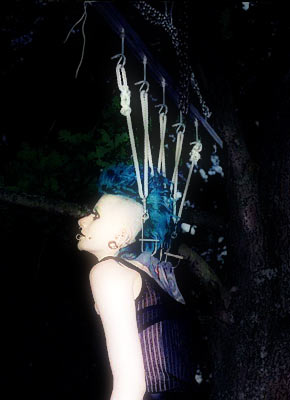
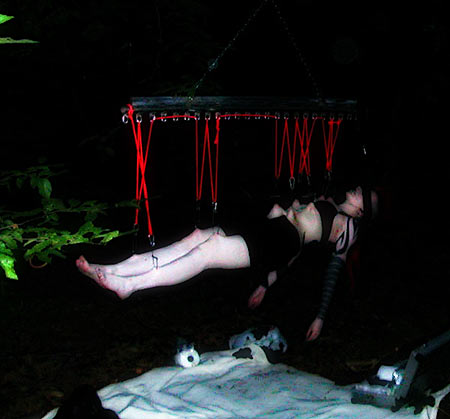
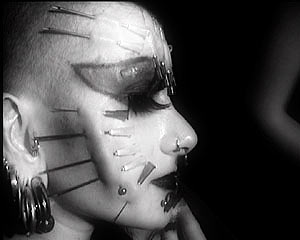


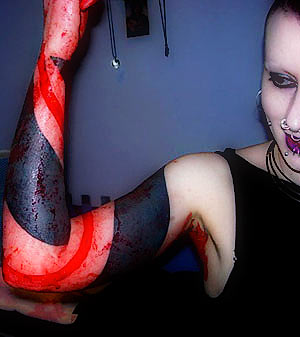

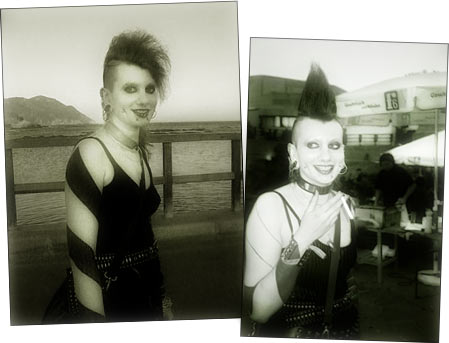
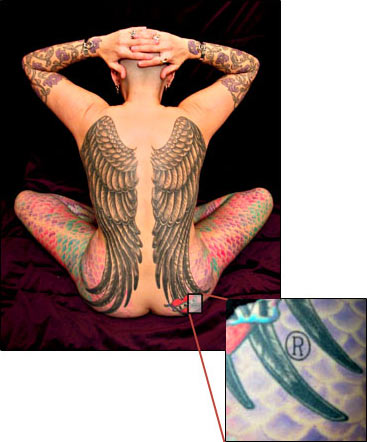
 Kathryn is a 21 year old welder from Melbourne, Australia. She plays the cello and has been getting modified for the past four years.
Kathryn is a 21 year old welder from Melbourne, Australia. She plays the cello and has been getting modified for the past four years.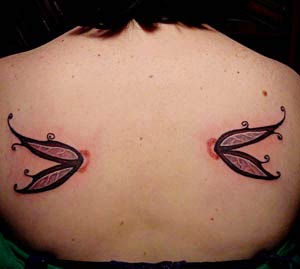 Désirée Fawn Kretschmar (IAM:
Désirée Fawn Kretschmar (IAM: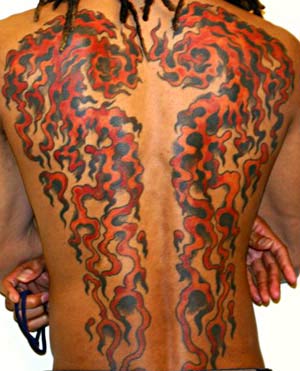 Mike Johnson is a 45 year old self-described Aries/Rat who lives in Charlottesville, Virginia. By day he does layout and design work for a local newspaper, picking up freelance work when he can, from business cards to CD designs for local bands. By night he’s a drummer who plays in alternative, hard rock, punk, or gothic groups, depending on where his head is at the time.
Mike Johnson is a 45 year old self-described Aries/Rat who lives in Charlottesville, Virginia. By day he does layout and design work for a local newspaper, picking up freelance work when he can, from business cards to CD designs for local bands. By night he’s a drummer who plays in alternative, hard rock, punk, or gothic groups, depending on where his head is at the time.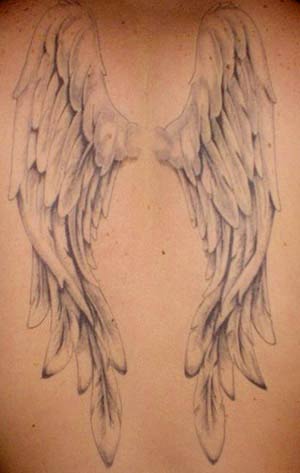 Nicole is a preschool teacher from Orlando, Florida who’s been modified for the past five years. She says that road rage is her worst habit, and she strongly dislikes it when people watch her being tattooed.
Nicole is a preschool teacher from Orlando, Florida who’s been modified for the past five years. She says that road rage is her worst habit, and she strongly dislikes it when people watch her being tattooed. Jenn (IAM:
Jenn (IAM: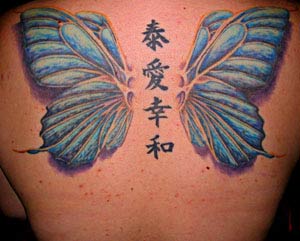 Marisa Terres is from Lompoc, California and is a 21 year old student. She’s interested in contortionism and wants to be able to sit on her own head someday.
Marisa Terres is from Lompoc, California and is a 21 year old student. She’s interested in contortionism and wants to be able to sit on her own head someday.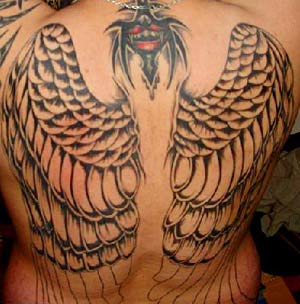 Pops (IAM:
Pops (IAM: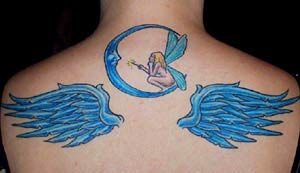 Emily (IAM:
Emily (IAM: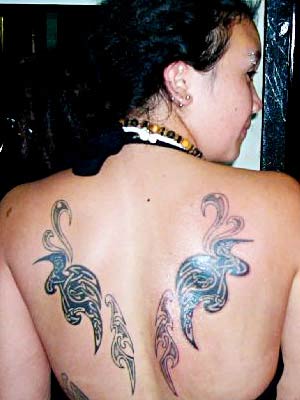 Sandra O’Conner (IAM:
Sandra O’Conner (IAM:

